Translate this page into:
Compartment syndrome of the upper arm following a blunt injury: A case report
*Corresponding author: Mazen A. Abdalla, Departments of Medicine, College of Medicine and Health Sciences, An-Najah National University and Orthopedic Surgery, An-Najah National University Hospital, Nablus, Palestine. mazen.abdalla@najah.edu
-
Received: ,
Accepted: ,
How to cite this article: Abdalla MA, Giannikas KA, Jaber MM, Zyoud SH. Compartment syndrome of the upper arm following a blunt injury: A case report. J Musculoskelet Surg Res. doi: 10.25259/JMSR_23_2025
Abstract
Compartment syndrome is a serious condition that develops due to increased pressure within the closed osteofascial compartment. This can increase pressure on the capillaries, nerves, and muscles in the compartment, which needs immediate diagnosis and treatment; otherwise, it might cause permanent damage to these structures. It mainly affects the leg and forearm and rarely the upper arm or upper leg. We are describing a compartment syndrome in the upper arm of a 55-year-old motorcyclist who was on oral anticoagulant (Apixaban) after blunt trauma. The clinical features, as well as reasons for the favorable outcome, are discussed. Cautions are suggested for similar injuries to avoid long-term disabilities.
Keywords
Anticoagulants
Blunt trauma
Compartment syndrome
Fasciotomy
Upper arm
INTRODUCTION
Compartment syndrome is a true emergency in orthopedic surgery. It is caused by increased interstitial pressure within the closed osteofascial compartment, impairing the local blood supply. It is of extreme importance to diagnose it early to avoid unfavorable complications. The diagnosis is usually made clinically and by repeated intra-compartmental pressure measurement.
The usual sites for compartment syndrome are the leg, forearm, hand, and foot. One of the rare sites is the upper arm. In most cases, it occurs after trauma,[1,2] biceps or triceps rupture,[3] sub-atmospheric pressure exposition,[4] tourniquet application,[5] shoulder dislocation,[6] as the result of a surgical complication,[7] blood pressure cuff malposition,[8] injections,[9] venipunctures,[10,11] and reperfusion injury.[12]
The arm fascia is relatively thinner and more elastic compared to other anatomical sites. This creates more space for the accumulation of blood and accommodates tissue swelling. Variability of tolerance to increased intercompartmental pressure may influence clinical onset and the course of the syndrome.[13,14] Patients undergoing anticoagulant therapy have increased susceptibility to bleeding, and sometimes, these drugs can facilitate the onset of acute compartment syndrome.
The relationship between acute compartment syndrome and warfarin treatment was first described by Hay et al. in 1992 in seven patients who sustained minor trauma in the lower limbs (six cases) and forearm (one case).[15]
We are reporting a case of subacute-onset compartment syndrome of the anterior compartment of the upper arm in a patient on an oral anticoagulant (Apixaban).
CASE REPORT
A 55-year-old overweight male on oral anticoagulants (Apixaban 5 mg PO BID) due to chronic atrial fibrillation claims that he hit his left upper arm into a solid obstacle while riding his motorcycle at a speed of no more than 30 km/hour. This resulted in losing his balance and control of his motorcycle, injuring his left ankle. One hour following his injury, he was seen at the emergency department. On presentation and following a primary survey, his injuries were noted to be limited to bruising and swelling at his left upper arm and a deformed left ankle. Apart from tenderness at the anterior compartment, no other abnormality was noted in his upper arm. He had full power at the ipsilateral shoulder and elbow, full range of all joints of the left upper limb, and no neurovascular deficit. Radiographs of the upper arm did not demonstrate any osseous abnormality. An arm-sling was given, and a simple armrest was advised. As for the left ankle, the patient was diagnosed with a bimalleolar fracture, and following provisional reduction, he was admitted for further surgical management.
Four hours following his admission and 7 h following his accident, the patient started complaining of severe pain in his left upper arm despite being on non-steroidal anti-inflammatory drugs (NSAID) for his ankle fracture. During the assessment of the emergency trauma staff, extreme tension was noted at the anterior compartment [Figure 1], pain at elbow movements, and inability of the patient to extend his hand [Figure 2]. Two-point discrimination at the radial nerve distribution at the hand was normal.
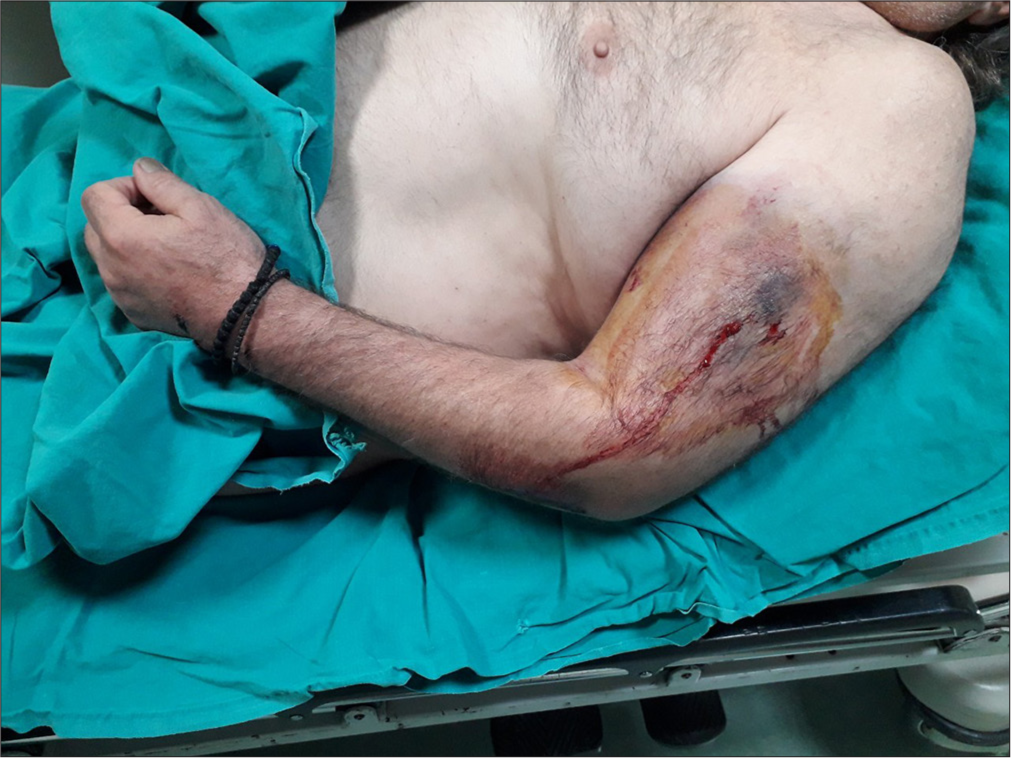
- The tense arm.
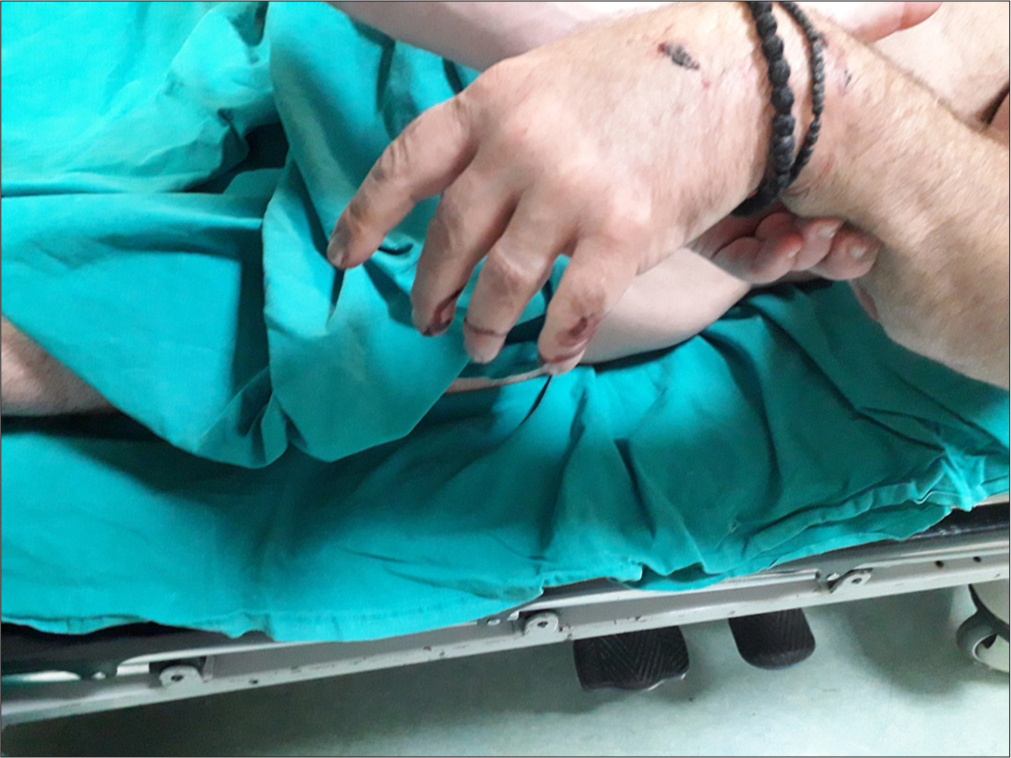
- The drop wrist sign.
The patient was taken to the emergency theater within the hour, was given general anesthesia with crush-induction, and a direct lateral incision was made at the upper arm. A large amount of blood clots was removed from the anterior compartment without any obvious muscle damage [Figures 3 and 4]. The radial nerve was not explored. The lateral septum was incised to reach the posterior compartment, but no macroscopic findings were noted. The wound was approximated with elastic bands without tension [Figure 5]. Two days following the decompression of his upper arm, the patient was taken to the theater to address his ankle fracture. In the same setting, the wound of the upper arm was primarily closed. He was discharged from the hospital 2 days after fracture fixation, 4 days following his initial injury.
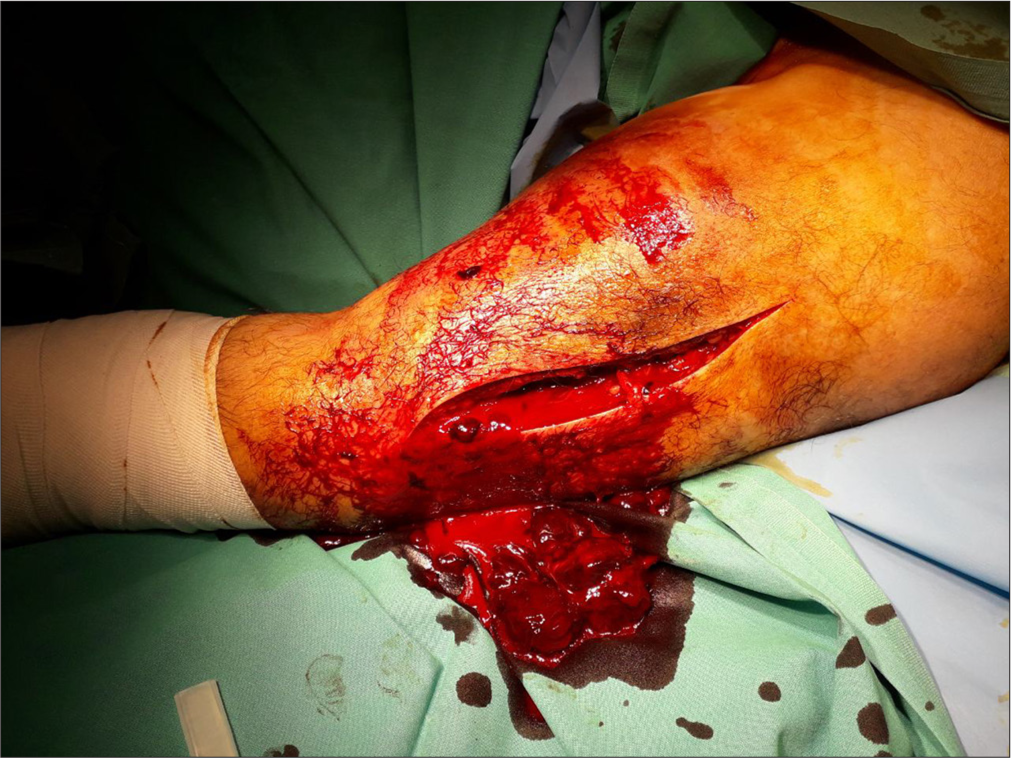
- The evacuated hematoma.
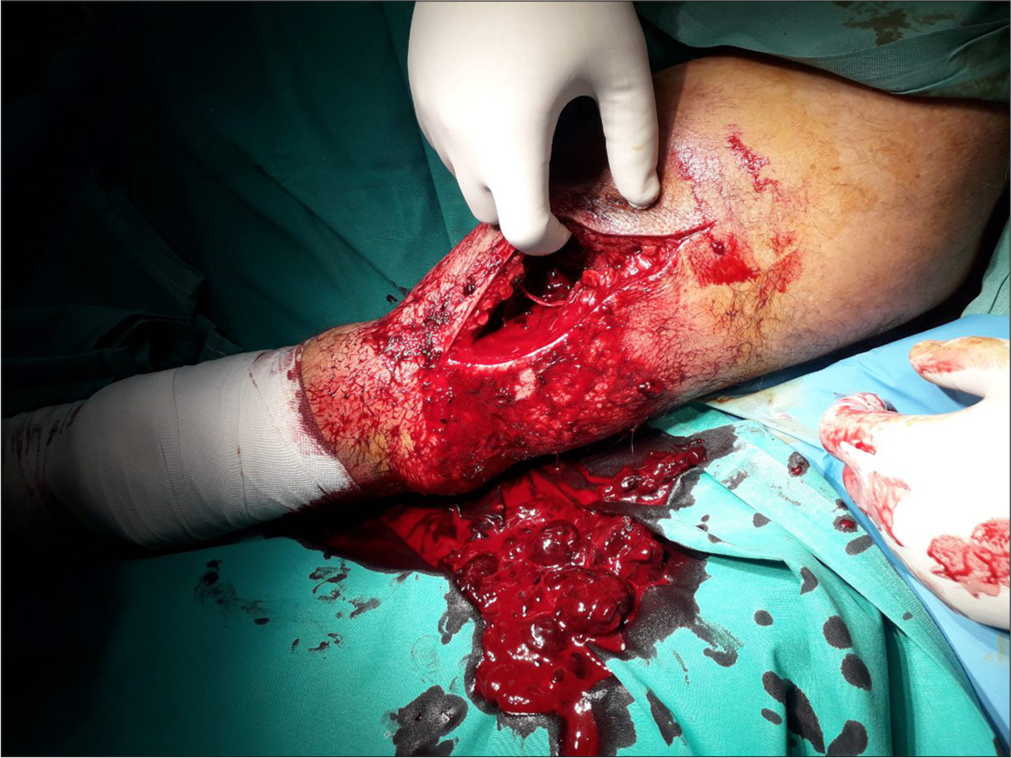
- The healthy muscles.
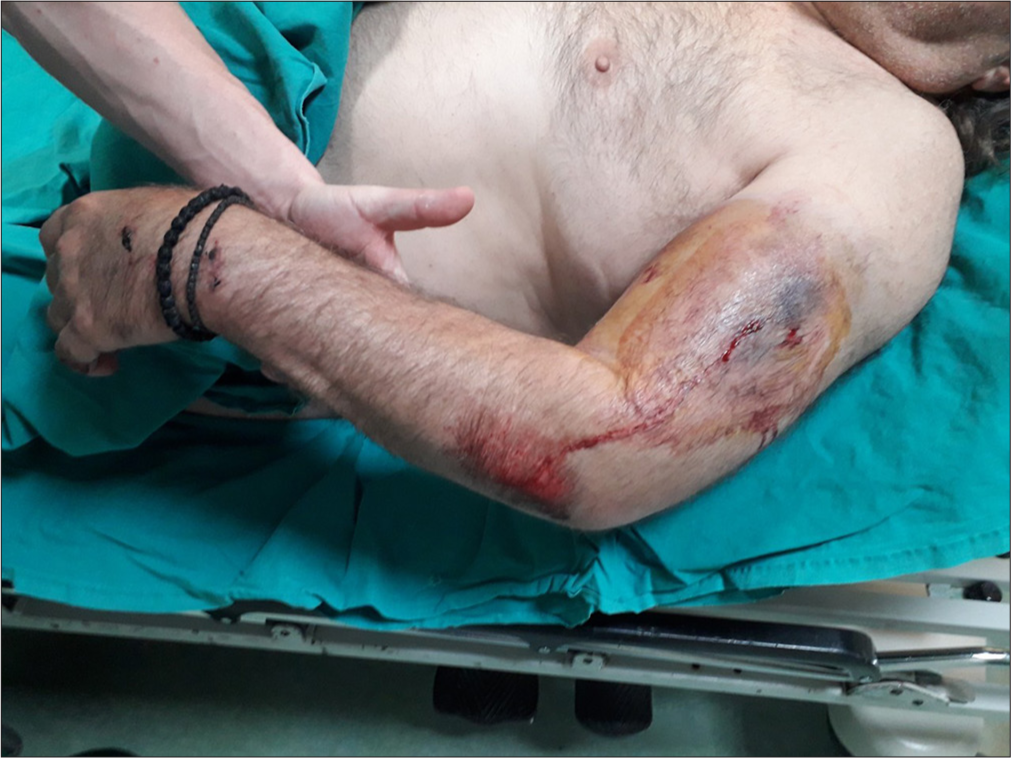
- The approximation of the edges with elastic band.
At discharge, he had no motor function of his radial nerve at the level of the forearm and hand. Sensation at the radial-nerve distribution area continued to be unaffected, with normal two-point discrimination (below 5 mm).
The patient was reviewed in the outpatient department for suture removal 2 weeks after fracture fixation. At that time, he partially recovered his radial nerve function, could dorsiflex his wrist against gravity, and had a full range of movement of all sectors and joints of his left upper limb. He was further reviewed at 2-week internals. At the 6-week visit, he had full function and power in his affected arm. No electromyographic studies were conducted due to his impressive rate of recovery. Further follow-up was arranged only for his ankle fracture.
DISCUSSION
There are few cases described in the literature describing acute compartment syndrome in the upper arm following blunt trauma without underlying fracture or muscle rupture. Most of them were on anticoagulants. In all described cases, the patients were at retiring age, on warfarin, with a high international normalized ratio (≥ 3.0). There was a delay in the diagnosis that ranged between 1 and 3 days and a further delay until the patients were optimized due to their disturbed coagulation profile.
In our case, the patient was younger, on a standard dose of anticoagulant, with no other symptoms in his left upper limb apart from some tenderness at the anterior compartment of the upper arm. To the best of our knowledge, there is no other report in the literature of compartment syndrome in the arm following the administration of Apixaban. If it had not been for the ankle fracture, he would probably not have qualified for hospital admission, as no existing literature suggests otherwise.
Our favorable outcome was multifactorial. The short time interval between the diagnosis and the surgical decompression was mostly due to the fact that the patient was admitted to an orthopedic ward for his ankle injury and was reassessed by staff that has inherent sensitivity in identifying compartment syndromes. It certainly helped that the sudden formation of the hematoma caused so much pain despite the NSAID given for his ankle fracture, which alerted the patient to request reassessment by the staff. It is of interest that the radial nerve deficit that developed was purely motor, perhaps suggesting that the decompression was achieved before the development of any sensory disturbances.
Furthermore, our case demonstrated that warfarin is not the only culprit of such a rare type of compartment syndrome, and all patients on anticoagulation therapy should equally raise suspicion of intracompartmental bleeding.
CONCLUSION
We strongly advise that patients under anticoagulation therapy, whether or not this is warfarin, who have sustained blunt trauma of any form should be assessed with suspicion of a potential compartment syndrome. Ideally, these patients should be admitted to an orthopedic ward, at least overnight, so they can be under the direct supervision of specialized trauma staff. In cases where the local department’s policy discourages such admissions, the patients should be given all the necessary alerts to return to the emergency department as soon as suspicious symptoms develop.
Authors’ contributions
MA: Contributed to the literature research and manuscript editing. MJ: Contributed to the literature review. KJ: Contributed to preparing the initial manuscript. SZ: Contributed to editing the final manuscript. All authors have critically reviewed and approved the final draft and are responsible for the manuscript’s content and similarity index.
Ethical approval
Institutional Review Board approval is not required.
Declaration of patient’s consent
The authors certify that they have obtained all appropriate patient consent forms. In the form, the patient has given his consent for his images and other clinical information to be reported in the journal. The patient understands that his name and initials will not be published, and due efforts will be made to conceal his identity, but anonymity cannot be guaranteed.
Use of artificial intelligence (AI)-assisted technology for manuscript preparation
The authors confirm that there was no use of artificial intelligence (AI)-assisted technology for assisting in the writing or editing of the manuscript and no images were manipulated using AI.
Conflicts of interest
There are no conflicting relationships or activities.
Financial support and sponsorship: This study did not receive any specific grant from funding agencies in the public, commercial, or not-for-profit sectors.
References
- Acute compartment syndrome of the upper arm: A report of 2 cases. Am J Orthop (Belle Mead NJ). 2005;34:498-500.
- [Google Scholar]
- Compression of the biceps-brachialis compartment after trivial trauma. J Bone Joint Surg Br. 1986;68:374.
- [CrossRef] [PubMed] [Google Scholar]
- Compartment syndrome complicating avulsion of the origin of the triceps muscle. A case report. J Bone Joint Surg A. 1987;69:1445-7.
- [CrossRef] [Google Scholar]
- Subatmospheric pressure-induced compartment syndrome of the entire upper extremity. A case report. J Bone Joint Surg Am. 2004;86:2041-4.
- [CrossRef] [PubMed] [Google Scholar]
- Compartment syndrome of the arm--a complication of the pneumatic tourniquet. A case report. J Bone Joint Surg Am. 1983;65:270-3.
- [CrossRef] [PubMed] [Google Scholar]
- Inferior dislocation of the glenohumeral joint combined with the compartment syndrome of the upper arm: Case report. Changgeng Yi Xue Za Zhi. 1998;21:358-61.
- [Google Scholar]
- Fatal acute compartment syndrome in patients after surgical treatment: 2 case reports. Legal Med (Tokyo). 2009;11(Suppl 1):S544-5.
- [CrossRef] [PubMed] [Google Scholar]
- Compartment syndrome: Time from diagnosis to fasciotomy. J Surg Orthop Adv. 2005;14:117-21.
- [Google Scholar]
- Prolonged cholinergic crisis and compartment syndrome following subcutaneous injection of an organophosphate compound for suicide attempt. J Forensic Legal Med. 2008;15:256-8.
- [CrossRef] [PubMed] [Google Scholar]
- Compartment syndrome after simple venipuncture in an anticoagulated patient. J Emerg Med. 1999;17:647-9.
- [CrossRef] [PubMed] [Google Scholar]
- Compartment syndrome of the upper arm after pressurized infiltration of intravenous fluid. J Clin Anesth. 1997;9:428-30.
- [CrossRef] [PubMed] [Google Scholar]
- Compartment syndrome due to reperfusion injury from an axillary artery occlusion: A case report and review of the literature. J Orthop Case Rep. 2023;13:106-10.
- [CrossRef] [PubMed] [Google Scholar]
- A model compartmental syndrome in man with particular reference to the quantification of nerve function. J Bone Joint Surg Am. 1977;59:648-53.
- [CrossRef] [Google Scholar]
- Diagnosis and management of compartmental syndromes. J Bone Joint Surg Am. 1980;62:286-91.
- [CrossRef] [Google Scholar]
- Acute compartment syndromes resulting from anticoagulant treatment. BMJ. 1992;305:1474-5.
- [CrossRef] [PubMed] [Google Scholar]






